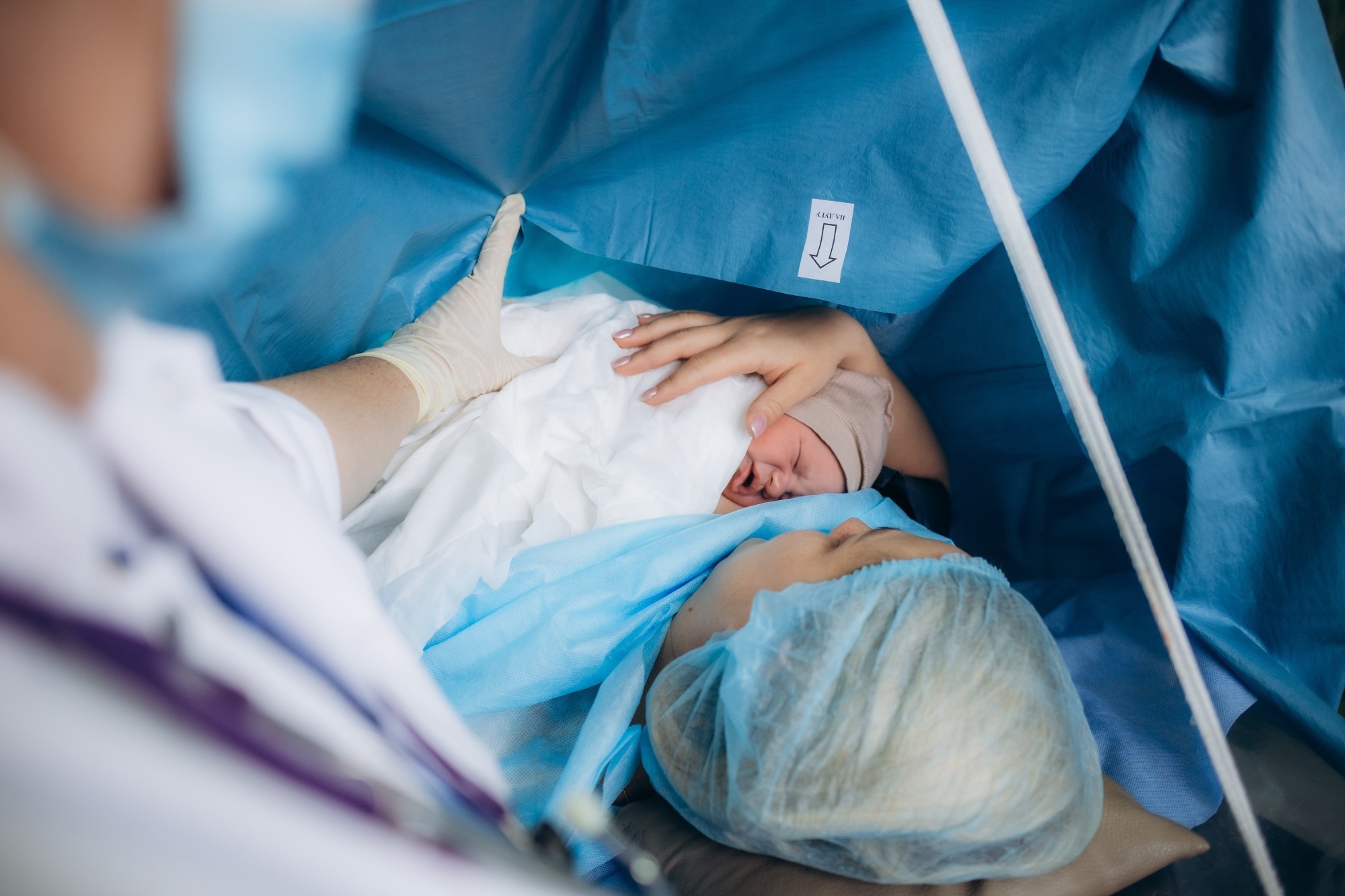A nationwide Japanese cohort finds no evidence that cesarean delivery increases early-life risks of eczema, wheezing, asthma, or atopic dermatitis, challenging concerns that birth mode alone drives infant allergic disease.

Study: Association of cesarean section with asthma and atopic dermatitis in infants from the Japan Environment and Children’s Study. Image Credit: Roman Fenton / Shutterstock
In a recent study published in the journal Scientific Reports, researchers in Japan investigated the associations between cesarean delivery and the development of eczema, wheezing, asthma, and atopic dermatitis in Japanese infants.
Increasing Allergy Burden in Childhood Health
The incidence of allergic diseases has recently increased worldwide. In Japan, allergic diseases are a significant health concern, with high rates of atopic dermatitis, wheezing, and asthma observed in children. Meanwhile, the rates of cesarean delivery have also increased globally. Children born by cesarean delivery exhibit an altered cytokine profile and gut flora compared to those born vaginally, though the clinical significance of these differences remains debated.
Delivery Mode as a Determinant of Immune Development
As such, the mode of delivery may be a crucial factor influencing the development of the immune system and disease incidence in infants. The relationship between cesarean delivery and allergic diseases remains controversial, as some studies suggest associations between allergic diseases and cesarean delivery, while others report no associations.
JECS Cohort and Study Population Characteristics
In the present study, researchers investigated associations between cesarean delivery and the development of eczema and wheezing among Japanese infants. The team utilized data from the Japan Environment and Children's Study (JECS), an extensive cohort study examining the impact of environmental factors on child health. The JECS included 103,062 pregnancies between January 2011 and March 2014.
Data Collection and Outcome Assessment Methods
The current study used the March 2018 dataset of the JECS and excluded those with miscarriage, multiple babies, or stillbirth. Self-reported questionnaires were administered to collect information about pregnancy and children. Atopic dermatitis, wheezing, asthma, and eczema were assessed based on information provided when the children were one year old. Participants were assigned to the vaginal or cesarean delivery group based on the delivery mode.
Classification of Emergency and Elective Cesarean Deliveries
The cesarean group was further stratified into an elective or emergency delivery group. Emergency cesarean delivery included non-reassuring fetal status, gestational hypertension syndrome, early membrane rupture, cephalopelvic disproportion, intrauterine infection, obstructed or delayed labor, and other complications.
Elective cesarean delivery included fetal malpresentation, placenta previa, repeat cesarean delivery, and a history of uterine surgery. The researchers used multiple logistic regression analyses, adjusted for potential confounders, to assess the risks of eczema, atopic dermatitis, asthma, and wheezing associated with cesarean delivery. Odds ratios and 95% confidence intervals were calculated.
Confounder Adjustment and Statistical Analysis Approach
Confounders included sex, parity, maternal age at pregnancy, gestational age (GA), maternal allergy history, smoking status, maternal passive smoking during pregnancy, pet ownership, marital status, small for GA (SGA), maternal education level, annual family income, breastfeeding at six months, and passive smoking exposure of infants. Finally, the team estimated associations between emergency and elective cesarean delivery and the risks of eczema, asthma, atopic dermatitis, and wheezing.
Distribution of Delivery Modes and Allergy Outcomes
The study included 74,639 mothers from the JECS. Of these, 81.6% underwent vaginal delivery and 18.4% underwent cesarean delivery. Among cesarean deliveries, 41.4% were emergency and 58.6% were elective deliveries. In infants born by cesarean delivery, the rates of atopic dermatitis, asthma, eczema, and wheezing were 4.2%, 2.7%, 18.1%, and 20.2%, respectively.
The corresponding rates in those born by vaginal delivery were 4.4%, 2.5%, 19%, and 19.5%, respectively. GA less than 39 weeks, parity two or more, SGA, maternal age at pregnancy 30 or older, maternal smoking during pregnancy, higher maternal education, higher annual family income, and pet ownership were associated with an increased incidence of cesarean delivery. In contrast, breastfeeding at six months and primipara were associated with a reduced incidence of cesarean delivery.
Regression Findings for Allergy and Respiratory Outcomes
Adjusted regression analyses revealed that cesarean delivery was not associated with a higher risk of wheezing, asthma, atopic dermatitis, or eczema in infants. All adjusted odds ratios had 95% confidence intervals that included 1.0. Similarly, elective delivery was not associated with an increased risk of eczema, wheezing, atopic dermatitis, or asthma. However, emergency delivery was associated with a reduced odds of eczema (adjusted odds ratio 0.91, 95% confidence interval 0.85 to 0.98), representing a modest 9% reduction in risk.
Interpretation of Findings and Diagnostic Limitations
Taken together, cesarean delivery was not associated with the development of eczema or wheezing in infants up to the age of 1. Similarly, emergency and elective cesarean deliveries did not increase the odds of eczema and wheezing.
The study treated eczema, defined as a recurrent itchy rash, and atopic dermatitis, defined as a clinician-diagnosed condition, as separate outcomes, a distinction relevant for clinical interpretation.
The study's limitations include the use of self reported data, which may have resulted in underreporting, a narrow outcome definition window within the first year of life, which may be too early to observe associations, particularly for asthma, which is difficult to diagnose reliably in infants, lack of data on disease severity, and potential unmeasured confounding, including possible misclassification between elective and emergency cesarean deliveries.
The authors frame these null findings as strong evidence against a meaningful association between cesarean delivery and the development of early allergic disease.
Journal reference:
- Maeda H, Hashimoto K, Iwasa H, et al. (2025). Association of cesarean section with asthma and atopic dermatitis in infants from the Japan Environment and Children's Study. Scientific Reports, 15(1), 39700. DOI: 10.1038/s41598-025-23252-z, https://www.nature.com/articles/s41598-025-23252-z